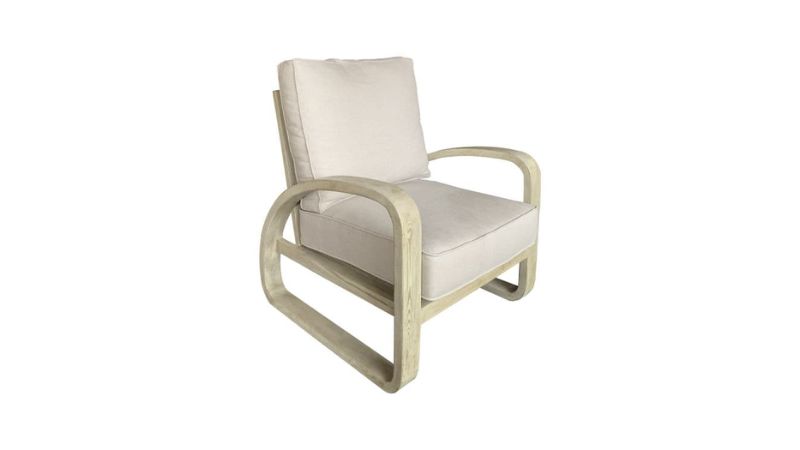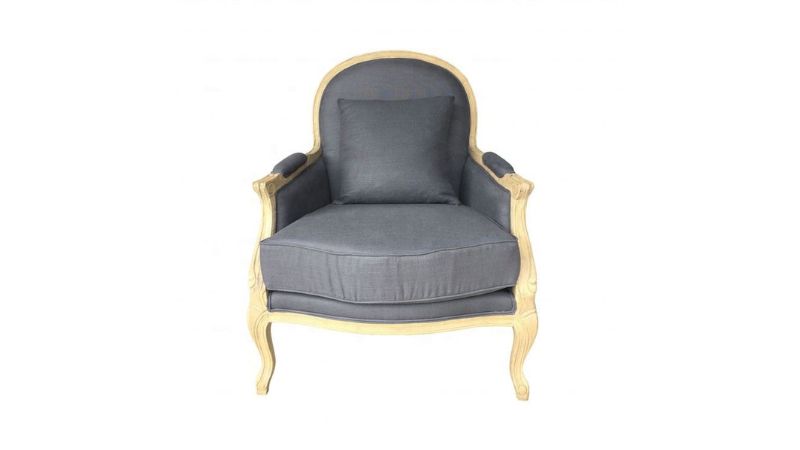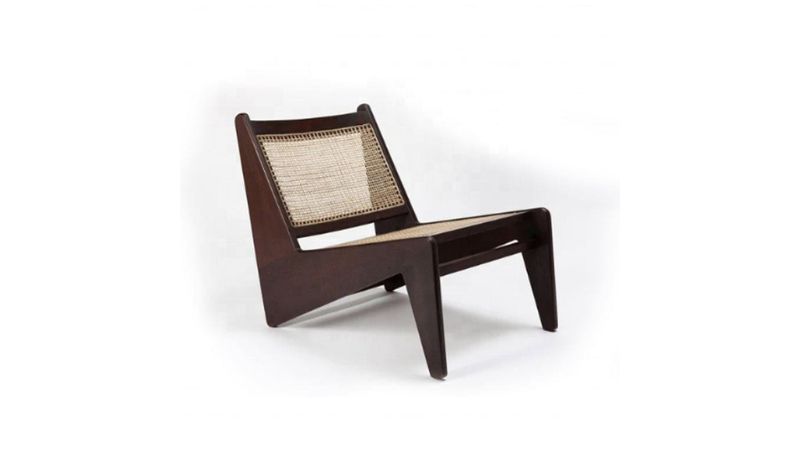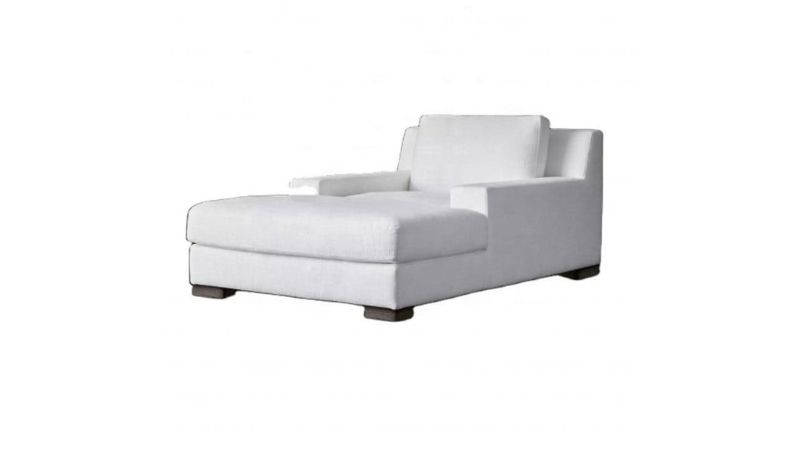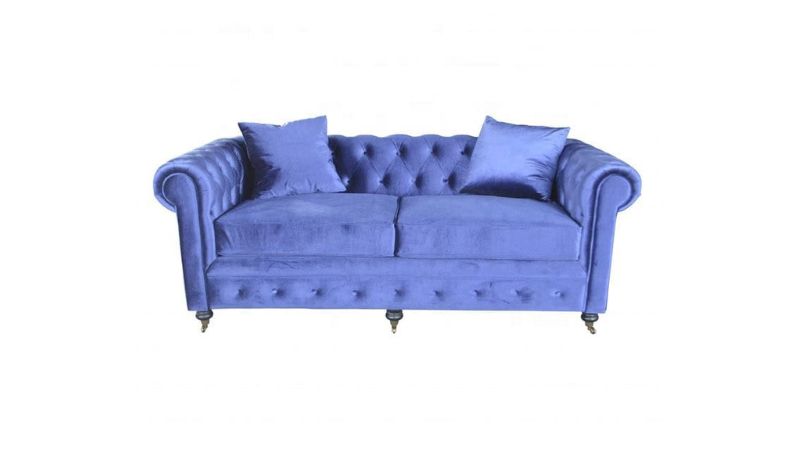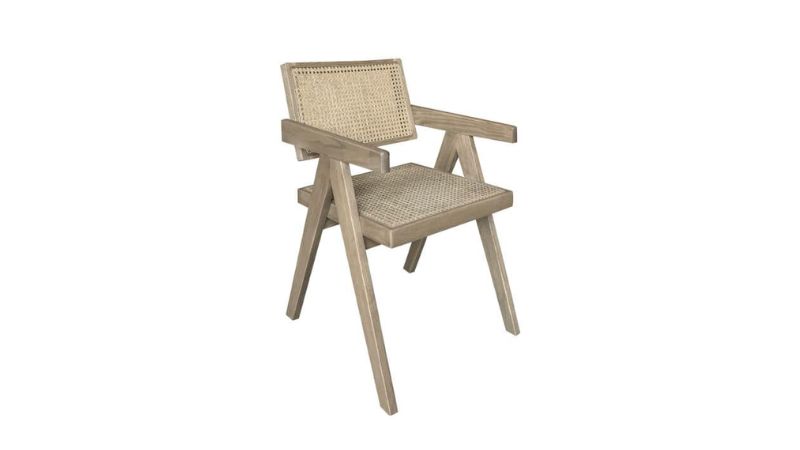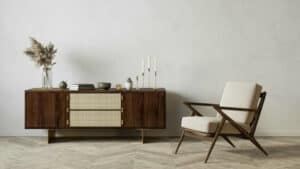
Every piece of furniture in your living room has a role to play. The sofa anchors the space, the tables offer utility, but the chair… the chair holds the power to transform it.
It is the most personal piece of furniture you can choose—a throne for reading, a nest for conversation, a sculptural statement that expresses individual style amidst a collective arrangement. While other furniture defines function, a chair defines feeling.
Yet, with so many styles, from sleek modern loungers to cozy, classic wingbacks, the search for the perfect chair can feel overwhelming. How do you choose the one that’s equal parts stunning and comfortable, that fits your space flawlessly, and that feels uniquely you? This guide will help you discover the 14 types of chairs and how to find the one that matches your space perfectly. Let’s find your seat.
1. Armchair
The armchair is the quintessential, versatile chair found in living rooms worldwide. It is a fully upholstered chair featuring a high back and two full armrests. Its design prioritizes comfort and support for extended sitting. Armchairs are often part of a matching furniture set with a sofa and loveseat but can also stand alone as a statement piece.
Suitable For: Primary seating, conversation areas, and reading nooks. Its classic design makes it suitable for almost any style, from traditional designs to modern styles, depending on its lines and upholstery.
2. Accent Chair
This is less of a specific structure and more of a functional category. An accent chair’s primary purpose is to add visual interest through its bold color, striking pattern, unique texture, or sculptural form. It can borrow design elements from slipper, arm, or barrel chairs but is always chosen to “accent” the room’s decor.
Suitable For: Injecting personality, breaking up monotony, and providing extra seating that serves as a focal point. Perfect for rooms that need a “pop”.
3. Slipper Chair
A sleek and simple armless chair that sits low to the ground. Its name originates from the 19th century, suggesting it was light enough for a woman to move around while wearing her slippers. The lack of arms gives it a compact, streamlined profile.
Suitable For: Small spaces, bedrooms, dressing areas, or as additional flexible seating in a living room. Its armless design allows it to be tucked neatly under a console table or desk when not in use.
4. Lounge Chair
This category encompasses iconic mid-century modern and contemporary designs that are celebrated for their form and innovation. Think of the Eames Lounge Chair or the Wegner Shell Chair. They often feature molded wood, leather, and metal, focusing on ergonomics and sculptural beauty.
Suitable For: Modern, minimalist, Scandinavian, and mid-century modern interiors. They function as both ultra-comfortable seating and standalone art pieces.
5. Chaise Lounge
From the French for “long chair,” a chaise lounge is designed for reclining. It features an elongated seat that fully supports the legs. It can be a freestanding piece (a récamier has two raised ends) or attached to a sofa at one end (a chaise section).
Suitable For: Luxurious lounging, reading, and resting. It adds a dramatic, relaxed, and sculptural element to a room, perfect for a bedroom or a spacious living area.
6. Recliner Chair
The pinnacle of functional comfort, a recliner allows the user to extend a footrest and lean the back into a reclined position. Modern versions often include power controls, USB ports, heating, and massage functions, moving far beyond the classic La-Z-Boy style.
Suitable For: Media rooms, man caves, and family rooms where ultimate relaxation and practicality are the top priorities. “Wall-hugger” models are ideal for smaller spaces.
7. Wingback Chair
A traditional chair characterized by its high back and distinctive “wings” or panels on either side. Originally, the wings were designed to protect the occupant from drafts in poorly insulated rooms and to trap heat from a fireplace.
Suitable For: Creating a cozy reading corner by a fireplace. It adds height, structure, and traditional elegance to a room, working well in classic, farmhouse, and even modern settings when executed in a contemporary fabric.
8. Rocking Chair
A chair with two curved bands (rockers) attached to the bottom of its legs, allowing it to rock back and forth. This gentle motion is known for its calming, soothing effect.
Suitable For: Nurseries, porches, and quiet corners for reading or relaxing. It evokes a sense of nostalgia and comfort, fitting well in cottage, farmhouse, and traditional homes.
9. Chesterfield Chair
Inspired by the iconic Chesterfield sofa, this chair is defined by its deep button-tufting, rolled arms that are level with the back, and a low, squat profile. Traditionally upholstered in leather, it exudes a sense of old-world, masculine elegance and luxury.
Suitable For: Studies, libraries, and formal living rooms. It suits traditional, Victorian, and modern eclectic styles, adding a touch of sophistication and heritage.
10. Swivel Chair
A chair mounted on a central rotating mechanism (swivel base) that allows it to turn 360 degrees. This base can be a pedestal, a sled base, or four legs with casters.
Suitable For: Conversation areas and open-plan living spaces where flexibility is key. It allows the user to easily engage with different parts of the room, other people, or a television.
11. Barrel Chair
This chair gets its name from its distinctive shape: a deep, rounded, semi-circular back that curves continuously into the arms, creating a cozy, enveloping “barrel” form. It often has a low back and a very plush seat.
Suitable For: Creating intimate, cocooning seating nooks. Its curved design works well to soften a room with sharp angles and suits traditional, transitional, and modern spaces.
12. Club Chair
A sturdy, deep, and generously proportioned chair with a low back and wide, padded arms. Traditionally upholstered in rich leather, it has a grounded, substantial feel. It evokes the comfort of a traditional English gentlemen’s club.
Suitable For: Studies, libraries, and dens. It brings a sense of relaxed, classic comfort to traditional, rustic, or masculine-themed interiors.
13. Cane Chair
A chair that features woven cane or rattan as a primary material, typically used for the backrest and sometimes the seat. This style brings natural texture, breathability, and a light, airy feel to a space.
Suitable For: Adding organic texture and a casual vibe. Perfect for coastal, cottagecore, Bohemian, and Scandinavian (Japandi) styles. It helps balance heavier furniture in a room.
14. Bergère Chair
A French classic representing formal elegance. A true Bergère is an enclosed armchair with a wooden frame that is visibly exposed on the arms, legs, and around the back. It features a loose, upholstered seat cushion and a tight, upholstered back panel within the frame.
Suitable For: Formal living rooms and classic, glamorous interiors. It adds instant sophistication and architectural detail. Often more ornate than a club chair, it is a statement piece of refined taste.
How to Choose the Perfect Living Room Chair
Choosing the best living room chair is about balancing function, comfort, aesthetics, and budget. It’s more than just picking a pretty chair; it’s about enhancing how you live in your space. Here is a comprehensive guide on how to choose a living room chair for your needs perfectly.
Step 1: Purpose (The “Why”)
Before you fall in love with a style, ask yourself what the chair’s primary job will be. This will immediately narrow your options.
- For Primary Seating: You need comfort, support, and durability. Look for high-quality construction, good back support, and comfortable armrests (Armchairs, Club Chairs, Recliners).
- For Occasional Guests: You might prioritize style and space-saving. A chair that can be tucked away or that adds a decorative touch is key (Slipper Chairs, Accent Chairs).
- For Reading/Relaxing: Prioritize supreme comfort, a high back for head support, and perhaps a place to set a drink or book (Wingback, Recliner, Lounge Chair, Barrel Chair).
- For a Focal Point: Choose a chair with bold design, color, or texture that makes a statement (Accent Chair, Modern Lounge Chair, Chesterfield).
- For a Small Space: Look for armless designs, compact silhouettes, or chairs with legs that create visual space (Slipper Chair, Cane Chair).
Step 2: Size
This is a critical and often overlooked step. A chair that’s too large will overwhelm the room, while one that’s too small will look insignificant.
- Measure Your Space: Use painter’s tape to mark out the chair’s footprint on your floor. This will give you a real sense of how much space it will occupy and how it affects traffic flow.
- Consider Proportion: The chair should be in scale with your other furniture. A massive recliner will dwarf a delicate sofa, while a petite slipper chair will get lost next to a large, overstuffed sectional.
- Leave Room to Move: Ensure there’s at least 30-36 inches for main walkways and 14-18 inches between the chair and a coffee table for comfortable legroom.
Step 3: Comfort
A beautiful chair is useless if it’s not comfortable. Never buy a chair without sitting in it first, if possible.
- Seat Depth: Your back should rest against the back of the chair while there are still 2-3 inches between the edge of the seat and the back of your knees. This is crucial for comfort.
- Seat Height: Your feet should rest flat on the floor with your knees at a roughly 90-degree angle.
- Back Support: The chair should support your entire back, especially the lumbar region. A high back is great for leaning your head back.
- Armrest Height: When sitting, your arms should rest comfortably on the armrests without your shoulders hunching up.
Step 4: Style
Your chair should feel like a natural part of the room, not an afterthought.
- Match Your Existing Style: Is your room Modern? Look for clean lines and minimalist shapes (e.g., Swivel Chair, Lounge Chair). Traditional? Consider detailed upholstery and classic forms (e.g., Wingback, Bergère, Chesterfield). Bohemian/Rustic? Natural materials are key (e.g., Cane Chair, Rocking Chair).
- Create Contrast: Sometimes, an intentionally contrasting style can work beautifully. A single modern chair in a traditional room can become a fascinating focal point.
- Color and Pattern: Decide if you want the chair to blend in (choose a neutral color from your existing palette) or stand out (choose a bold color or vibrant pattern as an Accent Chair).
Step 5: Material
The fabric affects the chair’s feel, durability, maintenance, and overall aesthetic.
Durability & Maintenance:
- Households with Kids/Pets: Choose performance fabrics, microfiber, leather, or synthetic blends. They are more resistant to stains, spills, and scratches.
- Low-Traffic/Formal Rooms: You can opt for more delicate materials like velvet, silk, or linen.
Feel & Aesthetics:
- Leather: Durable, ages beautifully, easy to clean (but can be cold and show scratches). Suits modern, industrial, and traditional styles.
- Velvet: Luxurious, soft, and rich in color. Adds a touch of glamour and works well in most settings.
- Linen/Cotton: Casual, breathable, and inviting. Wrinkles easily but fits well in coastal, cottage, and Scandinavian decor.
- Performance Fabrics: Many modern fabrics are treated to be stain-resistant and incredibly durable (e.g., Crypton, Sunbrella), making them a practical choice for any home.
Step 6: Budget
- Budget: Set a realistic budget beforehand. Remember, a well-made chair is an investment that can last for decades.
Conclusion
Your perfect living room chair is more than just a place to sit—it’s a reflection of your lifestyle, a touchpoint for comfort, and a key piece that brings your entire space together. By balancing purpose, proportion, and personal style, you can select a chair that not only enhances your decor but truly enhances how you live. So take these tips, trust your instincts, and get ready to enjoy your living room’s new favorite seat.

